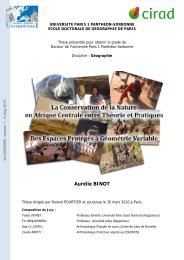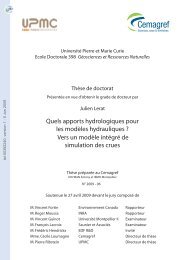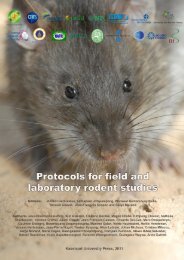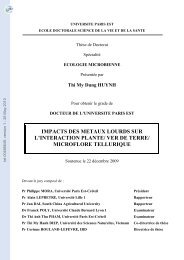Exploitation des eaux souterraines dans le périmètre irrigué de Tadla
Exploitation des eaux souterraines dans le périmètre irrigué de Tadla
Exploitation des eaux souterraines dans le périmètre irrigué de Tadla
You also want an ePaper? Increase the reach of your titles
YUMPU automatically turns print PDFs into web optimized ePapers that Google loves.
<strong>de</strong> la représentation graphique spatia<strong>le</strong> <strong>de</strong> l’information et n’est pas <strong><strong>de</strong>s</strong>tinée à la gestion <strong>de</strong> l’eau. I<strong>le</strong>st donc nécessaire <strong>de</strong> coup<strong>le</strong>r <strong>le</strong> SIG à <strong><strong>de</strong>s</strong> outils d’ai<strong>de</strong> à la gestion du périmètre afin <strong>de</strong> fournir <strong><strong>de</strong>s</strong>informations et <strong><strong>de</strong>s</strong> analyses pour <strong>le</strong>s instances <strong>de</strong> décision et <strong>de</strong> concertation <strong>dans</strong> l’allocation <strong><strong>de</strong>s</strong>ressources en eau et <strong>de</strong> la gestion <strong><strong>de</strong>s</strong> <strong>eaux</strong> <strong>souterraines</strong>.Démarche et méthodologie <strong>de</strong> travailL’Institut agronomique et vétérinaire Hassan II et d’autres institutions <strong>de</strong> recherche euroméditerranéens,en collaboration avec l’Office régional <strong>de</strong> mise en va<strong>le</strong>ur agrico<strong>le</strong> du <strong>Tadla</strong> etl’Agence du bassin hydraulique <strong>de</strong> l’Oum Er Rbia ont entrepris <strong><strong>de</strong>s</strong> recherches pour i<strong>de</strong>ntifier <strong><strong>de</strong>s</strong>modalités <strong>de</strong> gestion col<strong>le</strong>ctive et durab<strong>le</strong> <strong><strong>de</strong>s</strong> <strong>eaux</strong> <strong>souterraines</strong> <strong>dans</strong> une situation <strong>de</strong> forte pénuried’eau tout en tenant compte <strong><strong>de</strong>s</strong> caractéristiques <strong>de</strong> l’agriculture familia<strong>le</strong> <strong>dans</strong> <strong>le</strong> périmètre à travers<strong>le</strong>s projets Sirma et Aquastress.Cet axe <strong>de</strong> recherche constitue l’une <strong><strong>de</strong>s</strong> actions structurantes du projet SIRMA dont <strong>le</strong>s terrains sont<strong>le</strong> périmètre <strong>de</strong> <strong>Tadla</strong> au Maroc, la plaine <strong>de</strong> Kairouan en Tunisie et la plaine <strong>de</strong> la Mitidja ouest enAlgérie. L’objectif <strong>de</strong> cette action est <strong>de</strong> rechercher <strong><strong>de</strong>s</strong> règ<strong>le</strong>s <strong>de</strong> gestion conjuguée <strong><strong>de</strong>s</strong> <strong>eaux</strong> <strong><strong>de</strong>s</strong>urface et <strong>souterraines</strong> adaptées pour une efficacité non seu<strong>le</strong>ment individuel<strong>le</strong> mais aussi col<strong>le</strong>ctive.Ces activités réalisées <strong>dans</strong> <strong>le</strong> cadre <strong>de</strong> cette activité se situent à <strong>de</strong>ux échel<strong>le</strong>s. D’une part, àl’échel<strong>le</strong> <strong>de</strong> la zone d’action <strong>de</strong> l’ORMVAT, <strong>le</strong>s potentialités actuel<strong>le</strong>s <strong><strong>de</strong>s</strong> nappes <strong>souterraines</strong> ainsique l’exploitation actuel<strong>le</strong> et future seront déterminées pour comprendre quel rô<strong>le</strong> el<strong>le</strong>s peuvent jouer<strong>dans</strong> l’atténuation <strong><strong>de</strong>s</strong> pénuries d’eau <strong>de</strong> surface. A l’échel<strong>le</strong> <strong>de</strong> l’exploitation agrico<strong>le</strong> pourcomprendre <strong>le</strong>s stratégies <strong><strong>de</strong>s</strong> agriculteurs quant à l’accès <strong><strong>de</strong>s</strong> <strong>eaux</strong> <strong>souterraines</strong> et d’analyser <strong>le</strong>spratiques <strong>de</strong> pompage, <strong>de</strong> gestion <strong><strong>de</strong>s</strong> <strong>eaux</strong> <strong>souterraines</strong> et <strong>de</strong> <strong>le</strong>ur valorisation. Des outils serontproposés pour permettre au gestionnaire <strong>de</strong> mieux contrô<strong>le</strong>r la ressource en eau souterraine et <strong>de</strong>mieux la gérer conjointement aux <strong>eaux</strong> <strong>de</strong> surface afin d’assurer sa durabilité et l’équité <strong>de</strong> sonutilisation.La méthodologie proposée se base sur un travail intensif <strong>de</strong> terrain visant d’une part à une col<strong>le</strong>cted’information aussi bien sur <strong>le</strong> plan physique et technique que sur <strong>le</strong> plan socio-économique. Lecontour <strong>de</strong> l’intervention sur <strong>le</strong> terrain se résume comme suit :– la mise en place d’un système d’information à références spatia<strong>le</strong>s sur <strong>le</strong>s ressources en <strong>eaux</strong>, <strong>le</strong>ssystèmes aquifères, l’irrigation et <strong>le</strong>s systèmes <strong>de</strong> productions ;– évaluation <strong><strong>de</strong>s</strong> potentialités <strong><strong>de</strong>s</strong> <strong>eaux</strong> <strong>souterraines</strong> et <strong>le</strong>ur évolution à travers l’étu<strong>de</strong> <strong>de</strong> l’évolutionquantitative et qualitatives <strong><strong>de</strong>s</strong> <strong>eaux</strong> <strong>souterraines</strong>, <strong>de</strong> l’étu<strong>de</strong> <strong>de</strong> l’interaction entre <strong>le</strong>s différentssystèmes aquifères <strong>de</strong> <strong>Tadla</strong>, l’élaboration <strong><strong>de</strong>s</strong> bilans hydrogéologiques et l’étu<strong>de</strong> <strong>de</strong> l’apport <strong>de</strong> lamodélisation ;– la proposition d’un modè<strong>le</strong> basé sur <strong>le</strong>s bilans hydriques à l’échel<strong>le</strong> régiona<strong>le</strong> permettant <strong>de</strong> testerdifférents scénarios <strong>de</strong> gestion <strong><strong>de</strong>s</strong> <strong>eaux</strong> <strong>souterraines</strong> conjointement aux <strong>eaux</strong> <strong>de</strong> surface ;– la mise en œuvre d’une série d’enquêtes à l’échel<strong>le</strong> <strong>de</strong> l’exploitation agrico<strong>le</strong>. Ces enquêtesprennent différentes formes et peuvent être classées <strong>de</strong> la manière suivante :− une enquête exploitation agrico<strong>le</strong> sur environ 300 exploitations du périmètre irrigué. Cesexploitations ont été choisies pour couvrir l’ensemb<strong>le</strong> du périmètre (critère spatial), mais ont étésé<strong>le</strong>ctionnées <strong>de</strong> façon aléatoire (tirage au sort). L’enquête s’intéresse aussi bien aux productionsagrico<strong>le</strong>s qu’à la gestion et la valorisation <strong><strong>de</strong>s</strong> <strong>eaux</strong> d’irrigation et <strong>de</strong> pompage. L’enquête <strong>de</strong>vraitaboutir à une typologie <strong><strong>de</strong>s</strong> exploitations agrico<strong>le</strong>s <strong>dans</strong> <strong>le</strong> <strong>Tadla</strong> ;− une enquête sur <strong>le</strong>s arrangements autour <strong>de</strong> l’exploitation <strong><strong>de</strong>s</strong> <strong>eaux</strong> <strong>souterraines</strong> afin <strong>de</strong>déce<strong>le</strong>r <strong>le</strong>s meil<strong>le</strong>urs types d’organisation et pouvoir ainsi proposer une bonne stratégied’accompagnement pour l’exploitation col<strong>le</strong>ctive <strong><strong>de</strong>s</strong> <strong>eaux</strong> <strong>souterraines</strong> ;− une enquête <strong>de</strong> recensement exhaustif <strong><strong>de</strong>s</strong> puits et forages sur l’ensemb<strong>le</strong> du périmètre irrigué(100 000 ha) pour une meil<strong>le</strong>ure caractérisation <strong><strong>de</strong>s</strong> pompages permettant d’élaborer uneméthodologie <strong>de</strong> détermination <strong><strong>de</strong>s</strong> volumes pré<strong>le</strong>vés à partir <strong><strong>de</strong>s</strong> nappes <strong>souterraines</strong> ;− <strong><strong>de</strong>s</strong> suivis <strong>de</strong> quelques exploitations agrico<strong>le</strong>s, disposant <strong>de</strong> dispositif <strong>de</strong> pompage, pourdéterminer <strong><strong>de</strong>s</strong> usages <strong><strong>de</strong>s</strong> <strong>eaux</strong> <strong>souterraines</strong>, mieux comprendre <strong>le</strong> rô<strong>le</strong> que peuvent jouer <strong>le</strong>s<strong>eaux</strong> <strong>souterraines</strong> sur la prise <strong>de</strong> décision <strong><strong>de</strong>s</strong> agriculteurs, déterminer la valorisation <strong>de</strong> l’eausouterraine par différentes cultures et quantifier <strong>le</strong>s performances <strong><strong>de</strong>s</strong> dispositifs <strong>de</strong> pompage ;− après un travail d’analyse <strong>de</strong> données et <strong>de</strong> capitalisation <strong><strong>de</strong>s</strong> travaux <strong>de</strong> terrain, <strong><strong>de</strong>s</strong> ateliers<strong>de</strong> restitution et d’échanges avec <strong>le</strong>s acteurs sont prévus permettant d’orienter <strong>le</strong> choix d’outils ;4
















